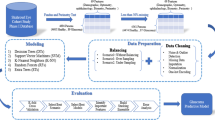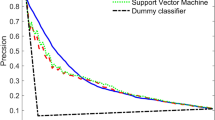Abstract
The purpose is to develop a pattern recognition model that would be able to classify three groups of glaucoma progression (which are: healthy controls, glaucoma suspects, and glaucoma patients) while being interpretable by medical doctors, being non-expert in machine learning. The utilized dataset is a numerical collection of 48 biomarkers acquired from each of 211 patients classified into three groups by an ophthalmologist. Due to the numerical type of the features and the high need for interpretability, it was decided to employ Classification and Regression Trees, and optimize them to obtain the smallest possible number of nodes and thus the highest interpretability while maintaining statistical dependence to the model with the highest quality metric from the review. The 5 \(\times \) 5 cross-validation protocol was used in the designed and conducted experiments. Two criteria were validated to assess the quality of the model selection – balanced accuracy metric and the number of nodes in the tree. The results indicate that this fairly simple approach could preserve a high balanced accuracy score and simultaneously reduce the size of the model – thereby increasing its interpretability. For \(\alpha = 0.2\), this approach can reduce the size of the Classification and Regression Trees to a quarter of its original spread.
Access this chapter
Tax calculation will be finalised at checkout
Purchases are for personal use only
Similar content being viewed by others
References
Quigley, H.A., Broman, A.T.: The number of people with glaucoma worldwide in 2010 and 2020. Br. J. Ophthalmol. 90(3), 262–267 (2006)
Tatham, A.J., Medeiros, F.A., Zangwill, L.M., Weinreb, R.N.: Strategies to improve early diagnosis in glaucoma. In: Progress in Brain Research, vol. 221, pp. 103–133. Elsevier (2015)
Kim, J.-A., Kim, T.-W., Weinreb, R.N., Lee, E.J., Girard, M.J.A., Mari, J.M.: Lamina cribrosa morphology predicts progressive retinal nerve fiber layer loss in eyes with suspected glaucoma. Sci. Rep. 8(1), 1–10 (2018)
Kurmann, T., et al.: Expert level automated biomarker identification in optical coherence tomography scans. Sci. Rep. 9(1), 1–9 (2019)
Yow, A.P., et al.: Automated circumpapillary retinal nerve fiber layer segmentation in high-resolution swept-source oct. In: 2020 42nd Annual International Conference of the IEEE Engineering in Medicine Biology Society (EMBC), pp. 1832–1835 (2020)
Sułot, D., Alonso-Caneiro, D., Iskander, D.R., Collins, M.J.: Deep learning approaches for segmenting Bruch’s membrane opening from OCT volumes. OSA Continuum 3(12), 3351–3364 (2020)
Maetschke, S., Antony, B., Ishikawa, H., Wollstein, G., Schuman, J., Garnavi, R.: A feature agnostic approach for glaucoma detection in OCT volumes. PLoS One 14(7), e0219126 (2019)
Ran, A.R., et al.: Deep learning in glaucoma with optical coherence tomography: a review. Eye 35(1), 1–14 (2020)
Murtagh, P., Greene, G., O’Brien, C.: Current applications of machine learning in the screening and diagnosis of glaucoma: a systematic review and meta-analysis. Int. J. Ophthalmol. 13(1), 149 (2020)
Weinreb, R.N., Khaw, P.T.: Primary open-angle glaucoma. The Lancet 363(9422), 1711–1720 (2004)
Vellido, A.: The importance of interpretability and visualization in machine learning for applications in medicine and health care. Neural Comput. Appl. 32(24), 18069–18083 (2019). https://doi.org/10.1007/s00521-019-04051-w
Kulikowski, C.A.: Pattern recognition approach to medical diagnosis. IEEE Trans. Syst. Sci. Cybern. 6(3), 173–178 (1970)
Krzyżanowska-Berkowska, P., Czajor, K., Iskander, D.R.: Associating the biomarkers of ocular blood OW with lamina cribrosa parameters in normotensive glaucoma suspects. Comparison to glaucoma patients and healthy controls. PLoS One 16(3), e0248851 (2021) (in review)
Loh, W.-Y.: Classification and regression trees. Wiley Interdisciplinary Rev. Data Min. Knowl. Disc. 1(1), 14–23 (2011)
Pedregosa, F., et al.: Scikit-learn: machine learning in Python. J. Mach. Learn. Res. 12, 2825–2830 (2011)
Tabachnick, B.G., Fidell, L.S.: Experimental designs using ANOVA. Thomson/Brooks/Cole Belmont, CA (2007)
Bergstra, J.S., Bardenet, R., Bengio, Y., Kegl, B.: Algorithms for hyper-parameter optimization. In: Advances in Neural Information Processing Systems, pp. 2546–2554 (2011)
Alpaydin, E.: Introduction to Machine Learning. MIT Press, Cambridge (2020)
Santafe, G., Inza, I., Lozano, J.A.: Dealing with the evaluation of supervised classification algorithms. Artif. Intell. Rev. 44(4), 467–508 (2015). https://doi.org/10.1007/s10462-015-9433-y
Acknowledgements
Special thanks to Paweł Ksieniewicz, from Wroclaw University of Science and Technology (wust), for help in the described research and to D. Robert Iskander, also from wust, for the guidance over the prepared manuscript.
Project supported by InterDok – Interdisciplinary Doctoral Studies Projects at Wroclaw University of Science and Technology, a project co-financed by the European Union under the European Social Fund, and by the Polish National Agency for Academic Exchange (nawa, ppi/apm/2019/1/00085/dec/1).
Author information
Authors and Affiliations
Corresponding author
Editor information
Editors and Affiliations
Rights and permissions
Copyright information
© 2022 The Author(s), under exclusive license to Springer Nature Switzerland AG
About this paper
Cite this paper
Sułot, D. (2022). Selection of Interpretable Decision Tree as a Method for Classification of Early and Developed Glaucoma. In: Piaseczna, N., Gorczowska, M., Łach, A. (eds) Innovations and Developments of Technologies in Medicine, Biology and Healthcare. EMBS ICS 2020. Advances in Intelligent Systems and Computing, vol 1360. Springer, Cham. https://doi.org/10.1007/978-3-030-88976-0_19
Download citation
DOI: https://doi.org/10.1007/978-3-030-88976-0_19
Published:
Publisher Name: Springer, Cham
Print ISBN: 978-3-030-88975-3
Online ISBN: 978-3-030-88976-0
eBook Packages: Intelligent Technologies and RoboticsIntelligent Technologies and Robotics (R0)




